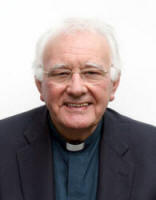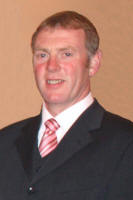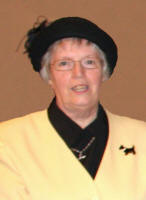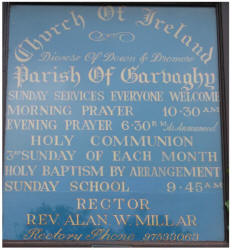
Garvaghy Church of Ireland
|
|
 |
| Garvaghy Church of Ireland thought to have been built in 1699 |
Rev Canon Charlie Leeke Rector |
 |
 |
_small.jpg) |
| Eric Lutton People’s Warden |
Thelma Steele Rector’s Warden. | Jacqueline Gee Diocesan Lay Reader |
Garvaghy Church of Ireland
Church Road, Garvaghy, Dromara.
Rector: Rev Canon Charlie Leeke
Telephone: 92650178
Diocesan Lay Reader: Jacqueline Gee
Sunday Services:
Morning Prayer: 10.30am
Evening Prayer: 6.30am (as announced)
1st, 2nd & 5th Sundays
Website: www.downanddromore.org
 |
| Notice Board |
HISTORY
Evidence that a church existed in Garvaghy as early as the 9th century is found in a small slab of rock engraved with a Celtic cross which was found by the late Mr James Ferguson while digging a grave. The authenticity of this stone as a grave marker was confirmed by staff at the Ulster Museum in Belfast. The first written record of a church in Garvaghy is dated 1422 when it was named the Vicarius de Garvagh.
Like many Episcopalian churches in County Down and elsewhere, the church was destroyed in the Uprising of 1641. During the Inquisition of 1657 it is said that only one yard of the walls remained. It is believed that the church was rebuilt using stones from the walls of the old church as its foundations and was re-consecrated in 1699. The building, with some alterations carried out over the centuries, is the one used by the present congregation for regular Sunday worship.
The rectory was built in 1820 at a cost of £800 and had 74 acres of glebe lands. After the Disestablishment of the Church Of Ireland in 1870, the church commissioners sold the glebe lands. However, the Select Vestry bought back the rectory and 4 acres (Irish) of land.
In 1885 the parishes of Garvaghy and Dromara were grouped and the vicar of the group lived in the rectory located on the edge of Dromara village. The Garvaghy rectory was purchased by the congregation of Garvaghy Presbyterian Church for their minister but in 1997 it was sold and is now a private dwelling.
In 1834 the church was described as a stone building, roughcast and whitewashed with a bell-cote at the west end. The date on the bell is 1743. The church is 60 feet long by 30 feet wide and the aisle is paved with limestone. There are 12 pews with a seating capacity of 120 people.
In 1895 the roof was replaced and the change of outline can clearly be seen from the present car park. A service of thanksgiving for the restoration of the building was held on 10th December 1897.
In 1955 the church was wired for electricity and in 1962, after piped water was brought to the building, an oil-fired heating system was installed to replace the old pot-bellied stove located in the middle of the church.
Following the closure of Garvaghy Primary School at the end of 1969, the property and attached land reverted to ownership of the church. In 1973 a car park was constructed beside the old school, which then became the parish halls.
In 1999 the church celebrated the 300th anniversary of the re-consecration of the building and throughout the year many events were held, including special services and a flower festival.
The Rev Canon Charlie Leeke, former Development Officer for Reconciliation in the Diocese of Down & Dromore (Think Again Team) will be instituted here on Tuesday 23rd September 2008. He succeeds the Rev Alan Millar who moved to St Comgall’s, Rathcoole in September 2006. Mrs Jacqueline Gee was commissioned as Diocesan Lay Reader in June 2004.
There are now just over forty families linked to the Garvaghy church and through their faithfulness, God’s work continues to flourish in this rural County Down parish.
George Musgrave, who resigned as People’s Warden in October 2006, compiled the above brief history. A book written by George Musgrave and the Rev Paul Thompson (former Rector of Garvaghy - 1992 to 1997) gives a detailed history of Garvaghy Parish Church. To see the book, click on: A Rough field. The story of Garvaghy Parish Co. Down.
